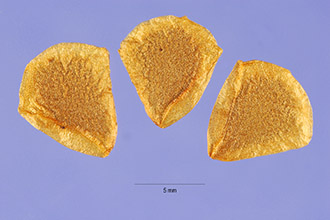Leopard Lily
Scientific Name: Lilium pardalinum Kellogg

| General Information | |
|---|---|
| Usda Symbol | LIPA |
| Group | Monocot |
| Life Cycle | Perennial |
| Growth Habits | Forb/herb |
| Native Locations | LIPA |
Plant Guide
Alternate Names
Tiger lily, panther lily
Uses
Ethnobotanic: There are five subspecies of leopard lily and probably all were utilized by various Native American cultural groups. The bulbs were pried loose from the earth with a digging stick, and baked or steamed by the Atsugewi, Yurok, Hupa, Karuk, Wailaki, Yana, and Sierra Miwok of California. A number of native people still dig the bulbs today. Tribes in northwestern California, for example, harvest the bulb in August or the fall, being careful to only take the large ones and replant the smaller bulb scales for later harvest. Traditionally, the Karuk baked the bulbs in an earth oven. The Sierra Miwok wore the flowers as wreaths. The bulbs are also eaten by small and large mammals.
Status
Please consult the PLANTS Web site and your State Department of Natural Resources for this plant’s current status, such as, state noxious status and wetland indicator values, Use soil moisture sensors to measure the soil moisture of Leopard Lily.,
Description
General: Lily Family (Liliaceae). This perennial herbaceous plant grows along stream banks and moist meadows below 2,000 m elevation. It has five subspecies (pardalinum, pitkinense (rare), shastense, vollmeri, and wigginsii). The stems are from 3 to 7 feet tall and the leaves appear in 1 to 8 whorls up the stem or are scattered. The leaves are linear to lanceolate, 1-2 dm. long. The branched rhizome is thick and fleshy and densely covered with two-jointed, sometimes three-or four-jointed bulb scales which are clonal. The bell-shaped flowers are one to many on long spreading pedicels. The flowers are pale to bright orange-red with a lighter orange center and purple spots on the lower half. The flowers are arranged in a terminal raceme. The capsule is narrowly oblong, acutely angled and one and one-half inches long and contain flat seeds. Alfred Brousseau © Brother Eric Vogel, St. Mary’s College @ CalPhotos
Distribution
For current distribution, please consult the Plant Profile page for this species on the PLANTS Web site. The plant is found along the coast of California in the coastal coniferous forests and in the mixed evergreen forests of the Coast Ranges and mixed conifer forests of the Sierra Nevada.
Establishment
Populations in the wild are declining because of habitat destruction and over-collection. Thus, do not collect these plants in the wild. If starting the plants from seed, plan on growing them for four years prior to out-planting. The seeds do not need stratification and can be planted in five or six-inch pots, one-quarter inch apart. Place the seeds on top of the soil, sprinkle soil on top and put one-quarter inch gravel on top of the soil. The seeds should be planted in well-drained soil and kept moist year round. Let the rain water the pots in winter. They should never be allowed to dry out. If there is not sufficient rain, supplement with hand watering. Put the pots outside in partial shade. The seeds will sprout by about March. After two years, separate the plants and space them four inches apart. Fertilize the plants in a weak solution once a month during the active growing period. Out-plant the plants after the third or fourth year in partial shade and keep them moist year round. They should be planted two to four inches deep. If establishing the plants from bulbs, the secret to good survival is to get good live roots on the bulbs. Plant them at whatever time of year you can obtain the bulbs, directly in the ground, two to four inches apart. Water them as noted above.
Management
Weed around the plants regularly and protect them from herbivory by small and large mammals. Deer for example, eat the flowers and bulbs. If the bulbs get too thick, separate them every several years, otherwise they may get choked. Cultivars, Improved and Selected Materials (and area of origin) Contact your local Natural Resources
Conservation
Service (formerly Soil Conservation Service) office for more information. Look in the phone book under ”United States Government.” The Natural Resources Conservation Service will be listed under the subheading “Department of Agriculture.” The leopard lily is available from many nurseries.
